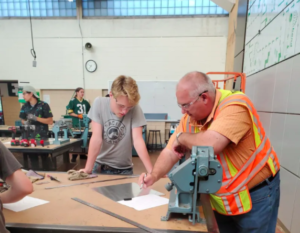Educators Support Career Pathways for Students to Build a Solid Future
Have you ever caught a student not paying attention in class? Maybe dozing off, chatting with another student, or taking glances at their cell phone?
Well, if you’re looking for a solution, you might want to consider the experience of Dan Rossiter, a construction teacher at White Bear Lake Area High School.
“I can’t say I have that problem,” said Rossiter. “Most days my students are trying to keep up with me in the woodshop.”
Rossiter has spent 27 years serving White Bear Lake Area High School where he mentors students interested in pursuing a career in the construction trades and advocates for skilled-work training and apprenticeship program opportunities.

Rossiter often works one-on-one with his students. He encourages them to apply their skills outside of class to projects in the community or around the house. (Photo Credit: WBLAHS taken before COVID regulations in summer 2019.)
White Bear Lake Area High School students can enroll in Career Pathways courses, learn industry-specific skills and, in some courses, earn college credit, free of charge, as well as industry-recognized credentials.
“We are evolving our courses to fit the interests of students and meet the needs of Minnesota’s future workforce,” Rossiter said. “We often partner with Construction Career Pathways and its website, ConstructionCareers.org, for career information and extracurricular activities that students can participate in throughout the school year to supplement their training.”
The Twin Cities-based nonprofit Construction Careers Foundation supports Minnesota educators such as Dan Rossiter with construction career resources and connections that they, in turn, can use to inspire and prepare Minnesota’s next generation of construction professionals.
At White Bear Lake Area High School, students who participate in the school’s construction trades program develop essential skills and experiences needed to either enter the workforce directly with a high-paying career or further their post-secondary education.
For example, students practice measuring and reading fractions, understanding hand and power tool safety, and learn how to use these skills to build a woodworking project. They also learn to read blueprints, design a floor plan and even work toward earning an OSHA 10 safety certification in construction.
“Working directly with educators at White Bear Lake Area High School and building the skills of students lays the foundation for students to excel in life beyond graduation, whether through continued education or a meaningful career in construction,” said Sarah Lechowich senior director for the Construction Careers Foundation, which oversees the Construction Career Pathways statewide initiative.
“Students aren’t sitting stagnant in a classroom,” Lechowich added. “Rather, they are engaging in hands-on classroom and field experiences, connecting with local industry professionals, touring local businesses, and other experiential learning opportunities.”
Rossiter mentors his students to explore their options and follow their passion after graduation. After all, there are more than 30 construction apprenticeship programs in Minnesota alone. Free mobile apps such as CCP’s Construction Trades serve as a great resource for students to explore careers, understand benefits and watch video advice from professionals in the field.
“I tell my students if you think you are not ready for, or not interested, in going to college and serving in the military isn’t right for you, then give the construction trades a trial run,” Rossiter said. “Students understand debt builds quickly and when they compare college expenses to the high wages and benefits they can earn right away through an apprenticeship, many want to dive deeper and see which construction career paths best match their interests.”

Rossiter also mentors young people through Construction Career Pathways’ Minnesota Trades Academy summer program. Students earn a wage while practicing construction apprenticeship skills and complete a variety of projects over the summer. (Photo Credit: WBLAHS, taken before COVID regulations in summer 2019.)
Rossiter’s students gravitate toward his positive attitude and interactive projects, but they often stay in touch with him after they graduate because he speaks from experience.
“I started in the construction trades when I was 16 as a shop hand helping around job sites and by 18, I was a laborer with a concrete crew,” Rossiter said. “I take pride in making sure my students build real-world connections while in school and showing them that the skills they practice in my class can put them on the fast track to a successful career right after graduation.”
